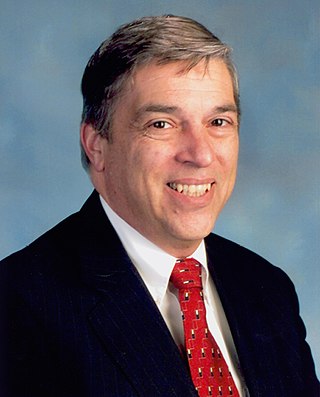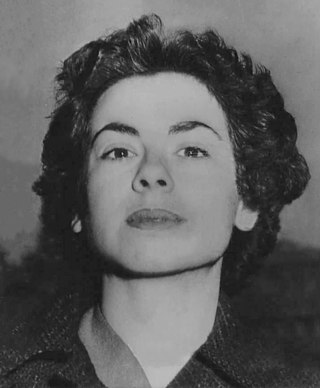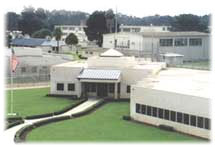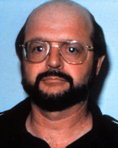
Cold War espionage describes the intelligence gathering activities during the Cold War between the Western allies and the Eastern Bloc. Both relied on a wide variety of military and civilian agencies in this pursuit.

Julius Rosenberg and Ethel Rosenberg were an American married couple who were convicted of spying for the Soviet Union, including providing top-secret information about American radar, sonar, jet propulsion engines, and nuclear weapon designs. Convicted of espionage in 1951, they were executed by the federal government of the United States in 1953 at Sing Sing in Ossining, New York, becoming the first American civilians to be executed for such charges and the first to be executed during peacetime. Other convicted co-conspirators were sentenced to prison, including Ethel's brother, David Greenglass, Harry Gold, and Morton Sobell. Klaus Fuchs, a German scientist working in Los Alamos, was convicted in the United Kingdom.

Robert Philip Hanssen was an American Federal Bureau of Investigation (FBI) agent who spied for Soviet and Russian intelligence services against the United States from 1979 to 2001. His espionage was described by the Department of Justice as "possibly the worst intelligence disaster in U.S. history".
Earl Edwin Pitts is a former FBI special agent who was convicted of espionage for selling information to Soviet and Russian intelligence services.

The Espionage Act of 1917 is a United States federal law enacted on June 15, 1917, shortly after the United States entered World War I. It has been amended numerous times over the years. It was originally found in Title 50 of the U.S. Code but is now found under Title 18. Specifically, it is 18 U.S.C. ch. 37.

The National Intelligence Organization, also known by its Turkish initials MIT or MİT, or colloquially as the Organization, is an intelligence agency of the Turkish government tasked with gathering information of national interests. It gathers information for the Presidency and the Armed Forces about the current and potential threats from inside and outside against all the elements that make up Turkey's integrity, constitutional order, existence, independence, security and national power and take precautions when necessary.

Judith Coplon Socolov was a spy for the Soviet Union whose trials, convictions, and successful constitutional appeals had a profound influence on espionage prosecutions during the Cold War.

Elizabeth Terrill Bentley was an American NKVD spymaster, who was recruited from within the Communist Party USA (CPUSA). She served the Soviet Union as the primary handler of multiple highly placed moles within both the United States Federal Government and the Office of Strategic Services from 1938 to 1945. She defected by contacting the Federal Bureau of Investigation (FBI) and debriefing about her espionage activities.

Ana Belén Montes is a former American senior analyst at the Defense Intelligence Agency in the United States who spied on behalf of the Cuban government for 17 years.
The Lawrence Franklin espionage scandal involved Lawrence Franklin, a former United States Department of Defense employee, passing classified documents regarding United States policy towards Iran to Israel. Franklin pleaded guilty to several espionage-related charges and was sentenced in January 2006 to nearly 13 years of prison, which was later reduced to ten months' house arrest. Franklin passed information to American Israel Public Affairs Committee policy director Steven Rosen and AIPAC senior Iran analyst Keith Weissman, who were fired by AIPAC. They were then indicted for illegally conspiring to gather and disclose classified national security information to Israel. However, prosecutors later dropped all charges against them without any plea bargain.
Richard W. Miller was an American FBI agent who was the first FBI agent indicted for and convicted of espionage. In 1991, he was sentenced to 20 years in prison but was freed after serving fewer than three years.

Harold James Nicholson is a former Central Intelligence Agency (CIA) officer who was twice convicted of spying for Russia's Foreign Intelligence Service (SVR).
James W. Hall III is a former United States Army warrant officer and signals intelligence analyst in Germany who sold eavesdropping and code secrets to East Germany and the Soviet Union from 1983 to 1988.
Chi Mak was a Chinese-born naturalized American citizen who worked as an engineer for California-based defense contractor Power Paragon, a part of L-3 Communications. In 2007, Mak was found guilty of conspiring to export sensitive defense technology to China. He was not formally charged with espionage as the information was not officially classified.

The Federal Correctional Institution, Lompoc is a low-security United States federal prison for male inmates in Lompoc, California. It is part of the Lompoc Federal Correctional Complex and is operated by the Federal Bureau of Prisons, a division of the United States Department of Justice.

John Anthony Walker Jr. was a United States Navy chief warrant officer and communications specialist convicted of spying for the Soviet Union from 1967 to 1985 and sentenced to life in prison.
Hüseyin Yıldırım is a Turkish-American auto mechanic who was sentenced to life imprisonment in the United States for his courier role in the espionage activities of U.S. serviceman James Hall III during the Cold War era. Yıldırım was later pardoned and extradited to his homeland, where he was sentenced to 17 years in prison but served only one day.

Susan Lindauer is an American journalist and former U.S. Congressional staffer who was charged with "acting as an unregistered agent of a foreign government" and violating U.S. financial sanctions during the run-up to the 2003 invasion of Iraq. She was incarcerated in 2005 and released the next year after two judges ruled her mentally unfit to stand trial. The government dropped the prosecution in 2009. In 2010, Lindauer published a book about her experiences. Since 2011 Lindauer has appeared frequently on television and in print as a U.S. government critic.

Anming Hu is a Chinese-Canadian academic who worked as an associate professor in the Department of Mechanical, Aerospace and Biomedical Engineering at the University of Tennessee, Knoxville (UTK) from 2013 to February 2020 when he was charged with fraud, after which UT suspended him.













